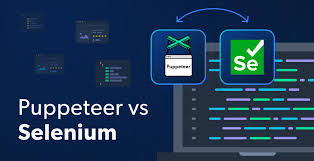Web testing is one of the crucial activities in the current software development process due to the necessity of web applications to work properly in different browsers and devices.
Now when it comes to the tools which are used for web testing, there are many, but the two most commonly used are Puppeteer and Selenium.
Here in this article, we are comparing Puppeteer vs Selenium to understand which tool is perfect for which requirements and job and which you should prefer.
What is Selenium?
Selenium is a popular tool that integrates with the web and is an open-source automation tool. It is compatible with different programming languages like Java, c #, Python, Ruby and so on, so testers can code scripts which mimic the action or behaviour of browsers as a human would.
Selenium Web Driver, being the most used one, is the component that specifically handles the browser, so it has the capability of testing an application built for the web in multiple browsers and operating systems.
Key Features of Selenium:
- Cross-Browser Testing: Selenium is compatible with widely used browsers like Chrome, Firefox, Safari, and Edge, which makes it useful for cross-browser testing.
- Language Flexibility: It is also evident that test scripts can be developed in many programming languages, which is an advantage to testers.
What is a Puppeteer?
Puppeteer is a Node. Any JS library which manipulates Chrome or Chromium browser and is developed by Google and offers a high-level API.
It is mainly designed for web applications in the field of automation and testing, but its functionalities are not just limited to generic web testing.
I found Puppeteer allows the developers to use JavaScript to control the browser, thus the library is commonly used by those working within the Node. js ecosystem.
Key Features of Puppeteer:
- Headless Browser Testing: Puppeteer is well suited for headlessly testing browsers because it doesn’t need the graphical interface to perform the tests and because it does not display the graphical user interface, it is faster at executing tests.
- Single Browser Focus: Since Puppeteer is developed with Chromium, it supports it better than other browsers, offering additional functions helpful only in Chrome.
- JavaScript and Node. JS: To take advantage of Puppeteer, one needs to know JavaScript and Node. The language of the application is jS, which makes the program ideal for developers who have a background in using these technologies.
- Advanced Browser Automation: In addition to automation of basic UI and browser testing uses, Puppeteer can be used in tasks that range from web scraping, and creating pdfs to screen shooting.
Selenium vs Puppeteer: A Comparative Analysis
To make the right choice between Selenium vs Puppeteer, the performer has to compare many parameters. Here is a detailed comparison:
- Browser Support:
- Selenium: Selenium can be used with most common browsers, like Chrome, Firefox, Safari and Edge, among others. This makes it perfect for cross-browsers as it runs on all the latest browsers.
- Puppeteer: Puppeteer is developed to work only with Chrome and Chromium. Although this offers tight coupling and many extensions available for these browsers, it reduces the cross-browser testing functionality.
- Programming Language Support:
- Selenium: Supports Java, C#, Python, Ruby etc. as URL parameters and JavaScript as the evaluated argument. It expresses that flexible options for teams are assigned to use the language that is most familiar to them.
- Puppeteer: Originally designed mainly for JavaScript and operates within a Node. js environment. This is suitable for teams that are already using these technologies and thus might be a drawback for other teams that prefer other languages.
- Ease of Setup and Configuration:
- Selenium: This is a more complex process, especially when it comes to the number of browsers and environments in place. This can complicate the testing process or scenario because it varies from application to application.
- Puppeteer: It is easier to configure, especially when testing is done in Chrome or Chromium browsers. Being a Node. Specifically, it naturally fits into projects that are written in JavaScript as it was developed using the JS library.
- Performance:
- Selenium: Speed depends on the browser type and configuration of the operating system you are using. It is relatively slower in comparison to Puppeteer, most particularly when running in headless mode.
- Puppeteer: It is known for its high performance, especially when working in headless mode. Puppeteer can run tests faster because it is headlessly integrated with Chrome and Chromium.
- Community and Support:
- Selenium: Has a large and engaged user base with a lot of extensive resources, manuals, and tutorials on the platform. This helps when one is in a situation where one can seek help from others who may have similar issues.
- Puppeteer: However, Puppeteer has a relatively smaller community size compared to Selenium, though the numbers are increasing daily. However, it is compensated by the support of Google, which would mean constant updates and modifications.
- Advanced Features:
- Selenium: Gives strong opportunities to test web applications in different frameworks and tools. However, it specialises in the competency of testing Web Applications.
- Puppeteer: It has features that are more than just testing functionalities, such as mouse & keyboard integration, PDF & screenshot capture, and web scraping. This makes it a very general application when it comes to automation services.
- Use Cases:
- Selenium: Suitable for extended cross-browser testing particularly in the context of using more than one programming language in a program. These particularities of Selenium also contribute to making it suitable for heavy and complex testing requirements where there is a great deal of browser support.
- Puppeteer: Most appropriate to solutions where Chrome or Chromium is the only or main browser used in the solution. It is very helpful for teams that work with JavaScript and Node, especially when they need to track down the error. js, and for tasks that are hard to automate within the browser.
Some Overview Use Cases and Use Scenarios
- Cross-Browser Testing: In this regard, selenium proves useful since it supports a variety of browsers. Hence, it can be used to test a web application in different environments.
- Multi-Language Support: Despite being more flexible, Selenium is not restricted to certain programming languages; thus, it can aid a variety of teams.
- Chrome/Chromium Specific Testing: Chrome and Chromium versions of browsers are supported best and Puppeteer is more optimized if used in Chrome or Chromium.
- JavaScript and Node. js Projects: Employees collaborate within JavaScript and Node. Puppeteers should be easy to integrate into and use with everyone in the JS ecosystem.
- Advanced Automation Tasks: Apart from the testing roles, I find Puppeteer to be very useful for numerous operations, such as crawling, creating PDFs or taking screenshots, mainly because Puppeteer is a versatile tool for automation.
Conclusion
While comparing both tools it is vital to understand that both tools are not directly comparable as each has its usage and suits a different situation altogether.
The support for different browsers, ability to work with different languages, and active community make Selenium ideal for the complex approach to Web application testing.
Nevertheless, the use of the concept can be hindered by the level of setup complexity as well as its performance.
With Puppeteer, work going specifically for Chromium and Chrome will be done with high performance, with a simple setup, and mainly with an increased level of automation.
Stay in touch to get more updates & news on Forbes Indo!










